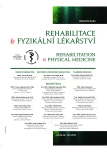Possible Application of Pilates Exercise in Multiple Sclerosis Patients
Authors:
K. Novotná 1,2; A. Gabrielová 1; M. Kövári 3
Authors‘ workplace:
Neurologická klinika a Centrum klinických neurověd, 1. LF a VFN v Praze
1; MS rehab z. s.
2; Klinika rehabilitace a tělovýchovného lékařství 2. LF UK a FN Motol, Praha
3
Published in:
Rehabil. fyz. Lék., 26, 2019, No. 3, pp. 115-119.
Category:
Original Papers
Overview
Background: Balance and gait impairment are common in people with multiple sclerosis (MS). This disabling deficit can be present even in people with mild neurological disability. People with MS are encouraged to perform some regular physical activity for improving fitness and muscle strength. Pilates is popular exercise system focusing upon controlled movement, activation of core muscles and breathing. The aim of the study was compare effect of short-term Pilates exercise on balance and gait performance in group of people with mild MS.
Methods: Participants received 10 weeks of training sessions of Pilates exercise (supervised by physiotherapist with experience in Mat Pilates exercise), control group has no change of lifestyle regimen. Balance was evaluated using Berg Balance Scale, MiniBest test, Timed Up and Go test, Single leg stance and Step test on baseline and after completing of training.
Gait performance was assessed using Timed 25 Foot Walk test, The 2-minute walk test and by GAITRite instrument.
Results: Thirty-three participants completed the study: 21 people in Pilates group (21 women, mean age 38.5 y, mean disease duration 6 y, mean EDSS 2.5) and 11 people in control group (1 man, mean age 43 y, mean disease duration 9 y, mean EDSS 2.9).
After completing 10 weeks of Pilates exercise participant significantly improved in balance (MiniBest test p=0.025, TUG p=0.041) and walking endurance (the 2-minute walk test p=0.002). Gait performance in normal walk measured by GAITRite was improved in both groups.
Conclusion: Pilates could be offered as possible exercise to people with mild MS to improve balance. However, for treatment serious balance deficit individual physiotherapy should be prescribed.
Keywords:
Multiple sclerosis – rehabilitation – exercise – Pilates
Sources
1. BULGUROGLU, I. et al.: The effects of mat Pilates and reformer Pilates in patients with multiple sclerosis: A randomized controlled study. NeuroRehabilitation, 41, 2017, 2, s. 413-422.
2. BYRNES, K., P., - WU, J., WHILLIER, S.: Is Pilates an effective rehabilitation tool? A systematic review. Journal of Bodywork and Movement Therapies, 2017.
3. DA LUZ Jr., M. A. et al.: Effectiveness of mat Pilates or equipment-based Pilates exercises in patients with chronic nonspecific low back pain: a randomized controlled trial. Physical Therapy, 94, 2014, 5, s. 623-631.
4. DUFF, W. R. et al.: Impact of Pilates exercise in multiple sclerosis: A randomized controlled trial. International Journal of MS Care, 20, 2018, 2, s. 92-100.
5. FOX, E. E. et al.: Effects of pilates-based core stability training in ambulant people with multiple sclerosis: multicenter, assessor-blinded, randomized controlled trial. Physical. Therapy, 96, 2016, 8, s. 1170-1178.
6. FREEMAN, J. et al.: Pilates based core stability training in ambulant individuals with multiple sclerosis: protocol for a multi-centre randomised controlled trial. BMC Neurology, 12, 2012, 1, s. 19.
7. GODI, M. et al.: Comparison of reliability, validity, and responsiveness of the mini-BESTest and Berg Balance Scale in patients with balance disorders. Phys. Ther., 93, 2013, 2, s. 158-167.
8. GUCLU-GUNDUZ, A. et al.: The effects of pilates on balance, mobility and strength in patients with multiple sclerosis. NeuroRehabilitation, 34, 2014, 2, s. 337-342.
9. HEESEN, C. et al.: Patient perception of bodily functions in multiple sclerosis: gait and visual function are the most valuable. Mult. Scler.,14, 2008, 7, s. 988-991.
10. KALRON, A. et al.: Pilates exercise training vs. physical therapy for improving walking and balance in people with multiple sclerosis: a randomized controlled trial. Clinical Rehabilitation, 31, 2017, 3, s. 319-328.
11. KUCUK, F. et al.: Improvements in cognition, quality of life, and physical performance with clinical Pilates in multiple sclerosis: a randomized controlled trial. Journal of Physical Therapy Science, 28, 2016, 3, s. 761-768.
12. MARANDI, S. M. et al.: A comparison of 12 weeks of pilates and aquatic training on the dynamic balance of women with mulitple sclerosis. International Journal of Preventive Medicine, 2013, 4 (Suppl 1), s. S110.
13. MARTIN, C. L. et al.: Gait and balance impairment in early multiple sclerosis in the absence of clinical disability. Mult. Scler., 12, 2006, 5, s. 620-628.
14. MOTL, R. W. et al.: Exercise in patients with multiple sclerosis. Lancet Neurol,, 16, 2017, 10, s. 848-856.
15. MOTL, R. W., MC AULEY, E., SNOOK, E. M.: Physical activity and multiple sclerosis: a meta-analysis. Multiple Sclerosis Journal, 11, 2005, 4, s. 459-463.
16. MULLIGAN, H. et al.: Combining self-help and professional help to minimize barriers to physical activity in persons with multiple sclerosis: a trial of the “Blue Prescription” approach in New Zealand. Journal of Neurologic Physical Therapy, 37, 2013, 2, s. 51-57.
17. TOMRUK, M. S. et al.: Effects of Pilates exercises on sensory interaction, postural control and fatigue in patients with multiple sclerosis. Multiple Sclerosis and Related Disorders, 2016, 7, s. 70-73.
18. VAN DER LINDEN, M. L. et al.: Pilates for people with multiple sclerosis who use a wheelchair: feasibility, efficacy and participant experiences. Disability and Rabilitation, 36, 11, s. 932-939.
Labels
Physiotherapist, university degree Rehabilitation Sports medicineArticle was published in
Rehabilitation & Physical Medicine

2019 Issue 3
Most read in this issue
- Interconnection of Physiotherapy and Psychology in Sport
- The Effect of Tibial Osteotomy on the Gait Kinematics in Patients with Knee Arthritis - Pilot Study
- Comparison of Time Requirements, Financial Accessibility and Reliability of Tests of Fine Motoric for Patients after Vascular Cerebral Stroke from the Ergotherapy Standpoint
- The Eeffect of Perfection of Motion Paradigm on Activation of Selected Muscles in an Open and Closed Kinematic Chain
